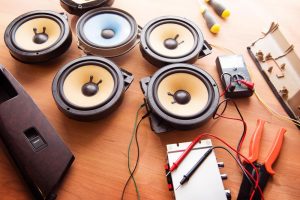 As a car owner, you have to know that Car Audio speakers can bring life into your music. Almost all cars have the ability to carry many types, size and shape of a speaker. But the problem is, there are several types of speakers like: BOSS Audio NX654 Onyx 6.5″ 4-Way Speakers, Kenwood KFC-6965S 3-Way Speakers, JVC CS-J620 2-Way Car Speakers, Rockford Fosgate R165X3 3-Way Car Speakers, Pioneer TS-A1675R 3-Way TS Series Car Speakers, Jaras JJ-2646 3-Way Car Speakers, JBL GTO628 2-Way Car Speakers, Alpine SPS-610C 2-Way Car Speakers, Infinity Reference 6032CF 2-Way Car Speakers and Kicker DS65 2-Way Car Speakers. With this long list of best car speakers, it becomes hard for first timers to know exactly what’s best for them.
As a car owner, you have to know that Car Audio speakers can bring life into your music. Almost all cars have the ability to carry many types, size and shape of a speaker. But the problem is, there are several types of speakers like: BOSS Audio NX654 Onyx 6.5″ 4-Way Speakers, Kenwood KFC-6965S 3-Way Speakers, JVC CS-J620 2-Way Car Speakers, Rockford Fosgate R165X3 3-Way Car Speakers, Pioneer TS-A1675R 3-Way TS Series Car Speakers, Jaras JJ-2646 3-Way Car Speakers, JBL GTO628 2-Way Car Speakers, Alpine SPS-610C 2-Way Car Speakers, Infinity Reference 6032CF 2-Way Car Speakers and Kicker DS65 2-Way Car Speakers. With this long list of best car speakers, it becomes hard for first timers to know exactly what’s best for them.
Match the new speaker to your system
Here, you have to consider two main specifications to identify the speaker that will do well in your car;
Sensitivity
Sensitivity is a measure of how much a speaker can yield from the power being applied to it. For those with low-powered car stereo of about 15 watts per channel or less, a speaker with very high sensitivity will be the best match. For the high-powered systems of 16 watts or more like the one obtained from external amplifiers or an aftermarket stereo, then a speaker with a very low sensitivity rating will be considered the best. Adequately powered systems will always provide an impressive sound.
Power-handling
Before settling for any car speaker, you need to know how much power in watts that speaker can handle. For the low-powered system, the speaker won’t need to deal with a lot of power. But for systems with large and powerful external amps, they’ll need a car speaker whose power-handling capability is close to that of the output of the amps. You have to know that the power-handling key spec is the maximum RMS and not the peak power handling. The ratings of RMS measures what a speaker can handle continuously not just for a shorter period. Therefore, a system with a score of 2-50 watts RMS is the best match for the low-powered system and that rated 10-80 watts RMS.
What type of speakers do you need?
 The aftermarket car speakers are divided into two main groups: Full-range speaker and component speaker systems.
The aftermarket car speakers are divided into two main groups: Full-range speaker and component speaker systems.
Full-range speakers
These speakers have elements in just one basket. They’re made up of a woofer for lows and a tweeter that’s mounted onto the woofer to give highs. Other models usually have drivers like super-tweeter or midrange. If you’re looking for a speaker that will handle minimum fuss and muss, the full-range is the best option. These speakers come in several sizes and can easily be mounted on your car. They’re found in almost all the price points and power range.
Component speakers
These are very excellent speakers that are designed to offer you the best sound quality. It consists of separate tweeters, woofers and crossovers that are made to work well with one another. In this system, you can mount the tweeter in a location to offer the very best imaging since it’s separate from the woofer. It gives a more realistic music sound that is more live and with greater depth. This crossover network of component system always comes externally to the tweeter and woofer. Therefore, a high-quality internal component is used to ensure there is a sharp delineation the frequencies sent to various drivers. They will also give you a realistic sound. Since these component systems are made of suitable material than the full-range speakers, they deliver an exceptional detailed and dynamic sound.
Speaker materials
The material of a speaker determines sound quality and its durability.
Woofer Materials
For you to produce good low notes in your music, your speaker should be made of very stiff and light material. Most manufacturers choose to make woofer cones of the car speaker from polypropylene which when mixed with mica becomes stiffer and gives a very accurate bass response. Synthetics woofer coated with titanium or aluminium metals are also very strong and light in weight thus offering a good response. All these woofer material withstands cold, heat and moisture as it’s required.
Tweeter materials
The material of the tweeter has a great effect on the sound quality that will be produced. Tweeter from soft materials such as silk, textile blends and poly produces a refined and mellow sound. If you’re a fun of snappy and highs bright, hard materials like ceramics, metal or graphite is your best choice.
Surround materials
The surrounding material on a woofer has a crucial role in allowing the woofer to emit bolder bass and move freely. These materials have to be durable to withstand extreme humidity and temperature. Surround materials from rubber offer the best longevity and overall performance. Cloth and foam surround are cheap and works well.
Pivoting or swivelling tweeters
Pivoting tweeters should be aimed towards the listener since they give out directional high-frequencies to offer a higher soundstage. The music will sound realistic with a very great sense of depth. The infinity’s UniPivot Tweeter has a design in the Reference X Series that helps you aim their high frequencies to your ear.
External crossovers
Clean separation between frequencies sent to tweeter and woofer is due to component systems using the passive external crossover. Energy is not lost by woofer and tweeter in trying to reproduce the frequencies that they’re not intended to. Therefore, you will just enjoy a more efficient and cleaner sound reproduction.
Most crossovers have additional input terminals that allow bi-amping. You don’t have to drive the tweeter and woofer with a single amplification channel; you just connect two cables sets. Each cable set carries a signal from a different amplifier. By doing that, both high-frequency drivers (tweeters) and low-frequency drivers (woofers) get a dedicated amplification. Before settling for any best car speaker, look for all these features.
Detachable tweeters
A speaker with detachable tweeters can be used well in both component systems and full-range speakers which are a good thing if you intend to use the speaker in different cars.
Match your speakers to your vehicle
When you are ready to install the new speaker in your car, use your car selector to know if that speaker fits in it.
Want to see the loudest cars in the world? Check out these slamology car audio contest photos from 2017.










